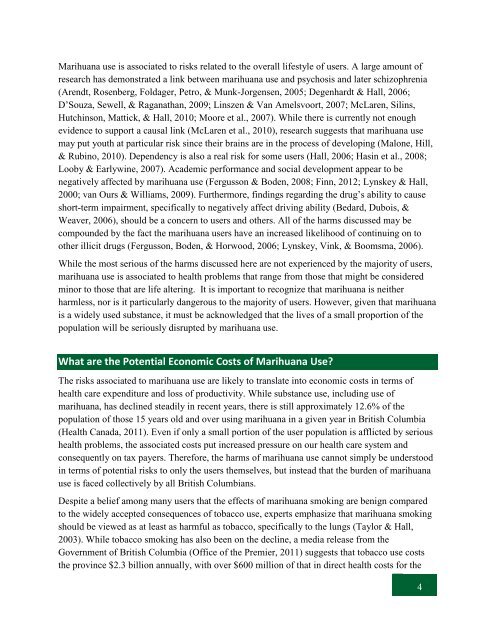Comercial+Grow+Op
Comercial+Grow+Op
Comercial+Grow+Op
You also want an ePaper? Increase the reach of your titles
YUMPU automatically turns print PDFs into web optimized ePapers that Google loves.
Marihuana use is associated to risks related to the overall lifestyle of users. A large amount of<br />
research has demonstrated a link between marihuana use and psychosis and later schizophrenia<br />
(Arendt, Rosenberg, Foldager, Petro, & Munk-Jorgensen, 2005; Degenhardt & Hall, 2006;<br />
D’Souza, Sewell, & Raganathan, 2009; Linszen & Van Amelsvoort, 2007; McLaren, Silins,<br />
Hutchinson, Mattick, & Hall, 2010; Moore et al., 2007). While there is currently not enough<br />
evidence to support a causal link (McLaren et al., 2010), research suggests that marihuana use<br />
may put youth at particular risk since their brains are in the process of developing (Malone, Hill,<br />
& Rubino, 2010). Dependency is also a real risk for some users (Hall, 2006; Hasin et al., 2008;<br />
Looby & Earlywine, 2007). Academic performance and social development appear to be<br />
negatively affected by marihuana use (Fergusson & Boden, 2008; Finn, 2012; Lynskey & Hall,<br />
2000; van Ours & Williams, 2009). Furthermore, findings regarding the drug’s ability to cause<br />
short-term impairment, specifically to negatively affect driving ability (Bedard, Dubois, &<br />
Weaver, 2006), should be a concern to users and others. All of the harms discussed may be<br />
compounded by the fact the marihuana users have an increased likelihood of continuing on to<br />
other illicit drugs (Fergusson, Boden, & Horwood, 2006; Lynskey, Vink, & Boomsma, 2006).<br />
While the most serious of the harms discussed here are not experienced by the majority of users,<br />
marihuana use is associated to health problems that range from those that might be considered<br />
minor to those that are life altering. It is important to recognize that marihuana is neither<br />
harmless, nor is it particularly dangerous to the majority of users. However, given that marihuana<br />
is a widely used substance, it must be acknowledged that the lives of a small proportion of the<br />
population will be seriously disrupted by marihuana use.<br />
What are the Potential Economic Costs of Marihuana Use?<br />
The risks associated to marihuana use are likely to translate into economic costs in terms of<br />
health care expenditure and loss of productivity. While substance use, including use of<br />
marihuana, has declined steadily in recent years, there is still approximately 12.6% of the<br />
population of those 15 years old and over using marihuana in a given year in British Columbia<br />
(Health Canada, 2011). Even if only a small portion of the user population is afflicted by serious<br />
health problems, the associated costs put increased pressure on our health care system and<br />
consequently on tax payers. Therefore, the harms of marihuana use cannot simply be understood<br />
in terms of potential risks to only the users themselves, but instead that the burden of marihuana<br />
use is faced collectively by all British Columbians.<br />
Despite a belief among many users that the effects of marihuana smoking are benign compared<br />
to the widely accepted consequences of tobacco use, experts emphasize that marihuana smoking<br />
should be viewed as at least as harmful as tobacco, specifically to the lungs (Taylor & Hall,<br />
2003). While tobacco smoking has also been on the decline, a media release from the<br />
Government of British Columbia (Office of the Premier, 2011) suggests that tobacco use costs<br />
the province $2.3 billion annually, with over $600 million of that in direct health costs for the<br />
4


